Physical Address
304 North Cardinal St.
Dorchester Center, MA 02124
Although it is affected by many diseases, the spleen is not considered a great challenge to the radiologist. In daily practice, the size and shape of the spleen typically are subjectively evaluated, and if there is no obvious splenomegaly or focal abnormality, the spleen usually is ignored. However, when abnormalities are detected, the radiologist plays an important role in providing a diagnosis and directing further clinical management.
Each imaging modality, including ultrasound, computed tomography (CT), magnetic resonance imaging (MRI), and scintigraphy, has specific advantages and limitations in assessing the spleen. Plain radiographs of the abdomen can detect splenomegaly and splenic calcifications but otherwise do not have a significant diagnostic role. Currently, angiography is used only for therapeutic purposes, such as splenic embolization in trauma, hypersplenism, or rare vascular tumors. 18F-fluorodeoxyglucose positron emission tomography (FDG PET) combined with CT (FDG PET/CT) is becoming increasingly useful in the evaluation of malignant disease and has a high negative predictive value in predicting a malignant neoplasm in patients with solid-appearing splenic masses. Because of a perceived high risk of bleeding, percutaneous biopsies of the spleen are not often performed in general practice. They are, however, relatively safe.
The various imaging appearances and characteristics of benign, intermediate, and malignant splenic lesions are described in this chapter. These can manifest as focal lesions, multifocal lesions, or a diffuse pattern with or without splenomegaly ( Table 62.1 ). ,
In 2018, a study suggested that in the case of an incidental splenic mass (without symptoms or evidence of malignancy), the likelihood of malignancy is very low (1%) and follow-up may not be warranted. However, in symptomatic patients or patients with a known malignancy, there is a large amount of overlap in imaging features between benign and malignant pathologies. Clinical assessment and history is important with regard to the lesion being symptomatic or asymptomatic. If the patient has a known disease, such as metastases, lymphoma, or tuberculosis, a general assumption is made that the focal abnormality represents splenic involvement.
Recognizing the range of the imaging and pathologic features of splenic abnormalities will narrow the differential diagnosis and help in planning further management. Exact pathologic diagnosis is sometimes not possible and radiologic interpretation often rather guides management and triage of patients regarding follow-up, further investigation (MRI, FDG PET, percutaneous biopsy), or ultimately splenectomy ( Fig. 62.1 ).
The differential diagnosis of cystic splenic masses is extensive and includes true or false splenic cysts, pseudocysts related to pancreatitis, parasitic (hydatid) cysts, pyogenic abscess, benign tumors of the spleen (e.g., hemangiomas, hamartomas, lymphangiomas, lymphoma), and cystic metastatic tumors. The correct diagnosis can usually be suggested by an analysis of clinical findings and symptoms, the medical history, and the appearance of the cyst.
Splenic cysts (true or false) are typically well defined, are of homogeneous water density (HU <20), and have a thin or imperceptible wall. After infection or hemorrhage, the cysts become more complex. A cystic splenic mass developing in a patient with pancreatitis is likely to be a pancreatic pseudocyst.
The presence of a cystic lesion with wall calcification and daughter cysts in a patient from an endemic area should raise the suspicion of cystic echinococcosis. Most cases of splenic hydatid cystic disease have coexisting hydatid liver disease.
Patients with a splenic abscess usually are sick or septic, and they present with fever, upper abdominal pain, and leukocytosis.
Benign splenic neoplasms (e.g., hemangioma, lymphangioma, hamartoma) may show single or multiple cystic spaces in the mass that rarely fulfill the criteria for a simple cyst. Splenic lymphoma may be manifested as ill-defined, hypoechoic masses with internal echoes on ultrasound or as low-density lesions with or without a thick rim on CT scans, mimicking a cystic lesion. Cystic metastases to the spleen have been reported from melanoma and adenocarcinoma of the breast and ovary, but they usually occur in the setting of widespread metastatic disease and typically have a complex appearance. Isolated splenic metastases are rare.
In Western countries, virtually all splenic cysts are asymptomatic and found during routine imaging. Symptoms may occur when the cysts are large and include left upper quadrant discomfort, fullness, and pain. Complications such as spontaneous hemorrhage, rupture, or secondary infection are rare.
Congenital cysts, also known as true, primary, epidermoid, or mesothelial cysts, have an epithelial or mesothelial cell lining and are thought to be developmental in origin. These account for approximately 10% of all splenic cysts, and they are not associated with cysts in other organs. Dermoid cysts of the spleen are rare and have been described in only a few case reports. The natural history of splenic cysts is unknown. No long-term follow-up reports of patients with splenic cysts have been published.
Pseudocysts, also known as secondary cysts or false cysts, do not have an epithelial lining and are thought to be the result of an intrasplenic hematoma, infarct, or infection.
In our opinion, small and asymptomatic cysts are best managed conservatively. Treatment of large and symptomatic cysts includes percutaneous aspiration with or without sclerotherapy and splenectomy.
Splenic parenchymal involvement is seen in approximately 6% of patients with pancreatic pseudocyst formation. Complications usually result from direct extension of a pancreatic pseudocyst and include splenic vein thrombosis, infarction, intrasplenic pseudocyst, subcapsular hematoma, splenic rupture, and hemorrhage from splenic artery pseudoaneurysm.
True and false cysts are unable to be differentiated on the basis of gross appearance. True cysts are typically unilocular and they have a trabeculated, shiny, pearly white lining. The fluid may be clear or turbid, and the color can be yellow, green, or brown, containing cholesterol or blood degradation products. , On microscopic examination, the epithelial lining is variable, and a stratified squamous epithelium is the most common finding. On occasion, septations or thick, partially calcified walls can be seen. , When inflammation or hemorrhage occurs in these cysts, the cellular lining may be replaced by nonspecific fibrous or granulation tissue, and histologic distinction between epidermoid cysts and pseudocysts becomes difficult.
Most pseudocysts are unilocular and have a smooth inner surface. The wall is formed by fibrous tissue with or without calcified components, and these cysts are often filled with serous or hemorrhagic fluid. ,
It is not possible to distinguish between true and false cysts with any imaging technique. The wall of a pseudocyst tends to be thicker. In certain instances, it may be possible to differentiate a cyst from splenomegaly by the observation of a round mass with a normal, intact splenic tip. Curvilinear calcifications may also help identify the presence of a splenic cyst ( Fig. 62.2 ).
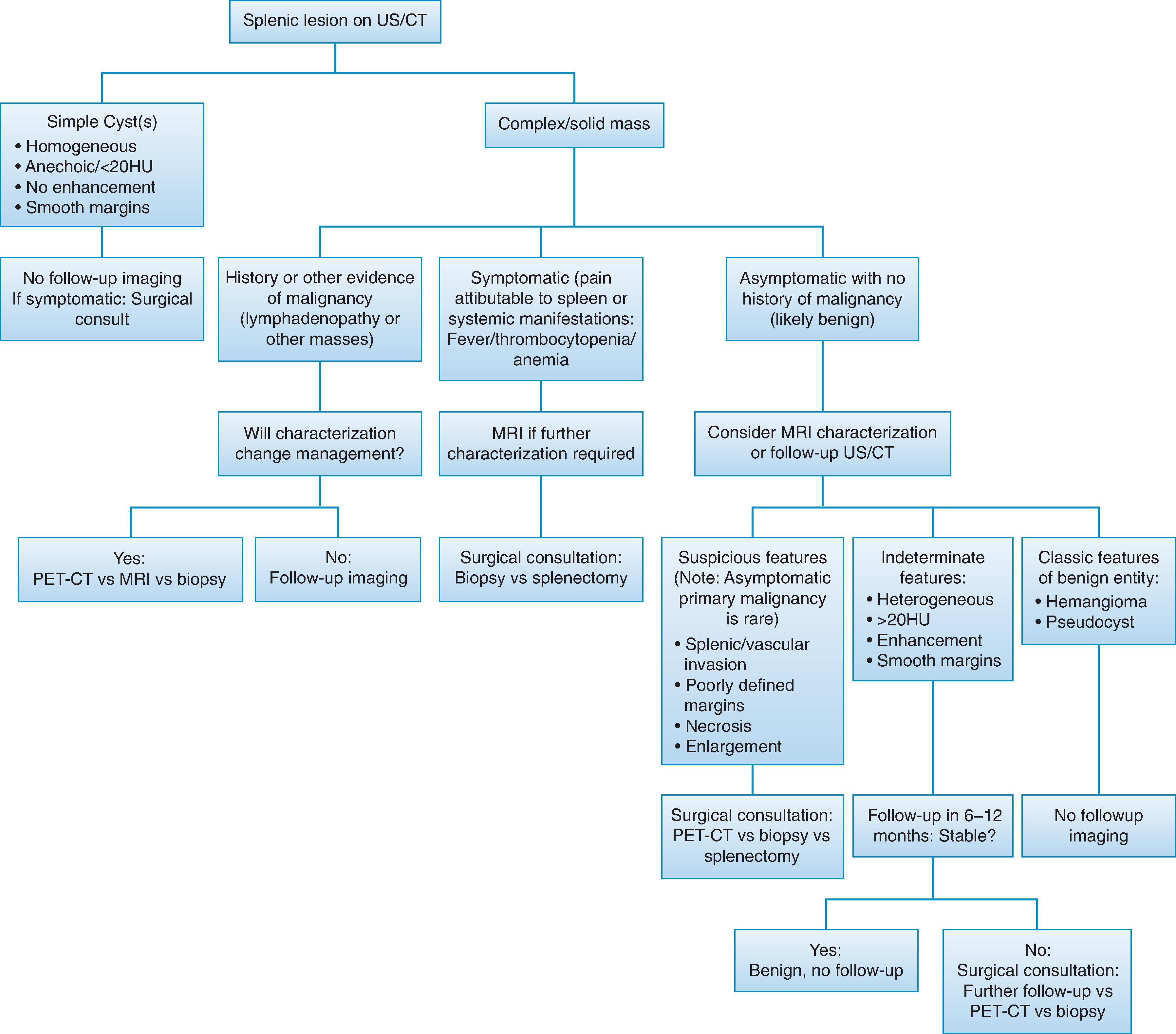
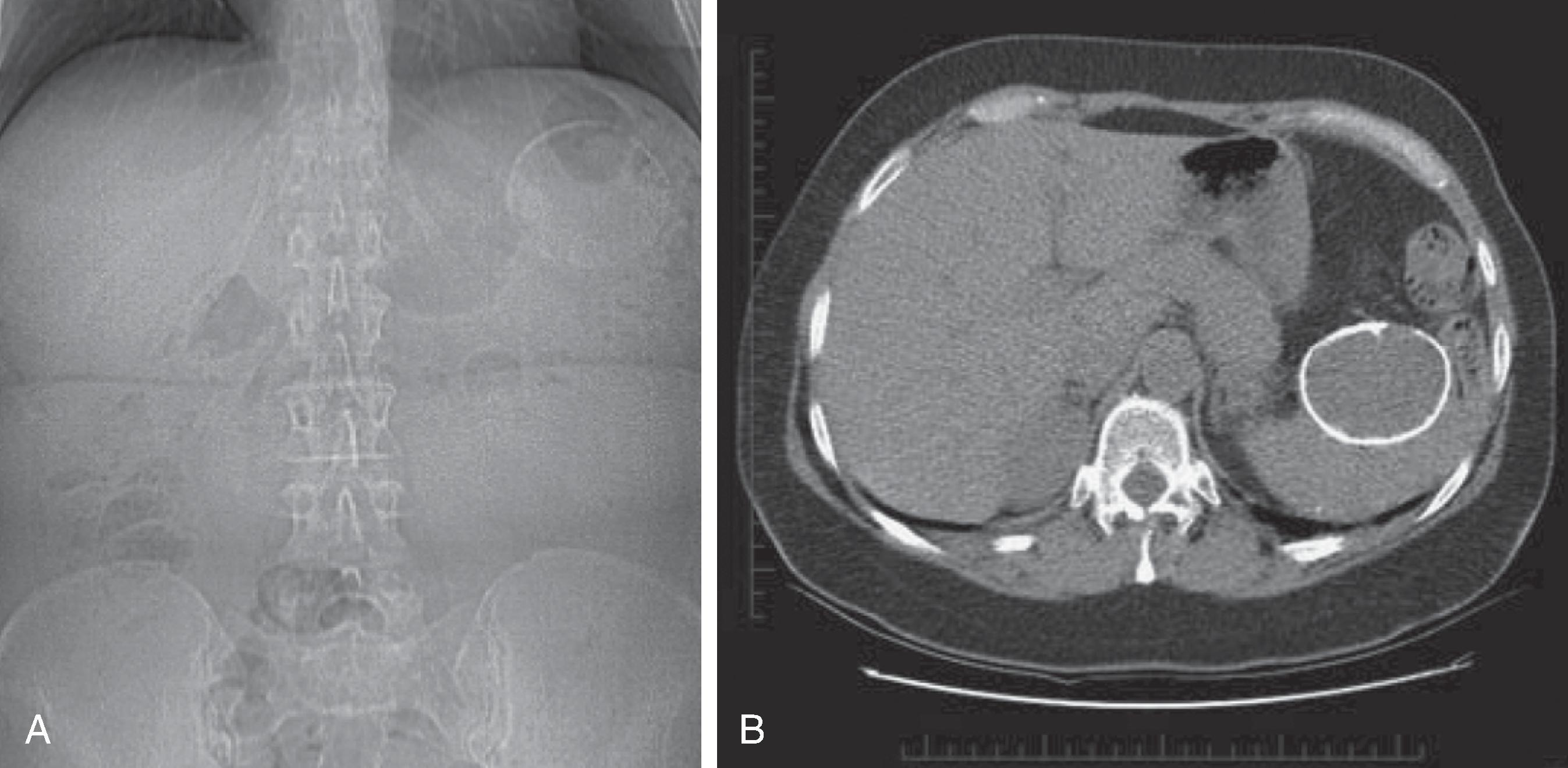
On ultrasound, splenic cysts, like cysts elsewhere in the body, characteristically appear as anechoic lesions with smooth borders and demonstrate increased through-transmission ( Fig. 62.3A ). Epidermoid cysts and pseudocysts may demonstrate septations, thick walls, trabeculations, internal echoes, and calcified walls.
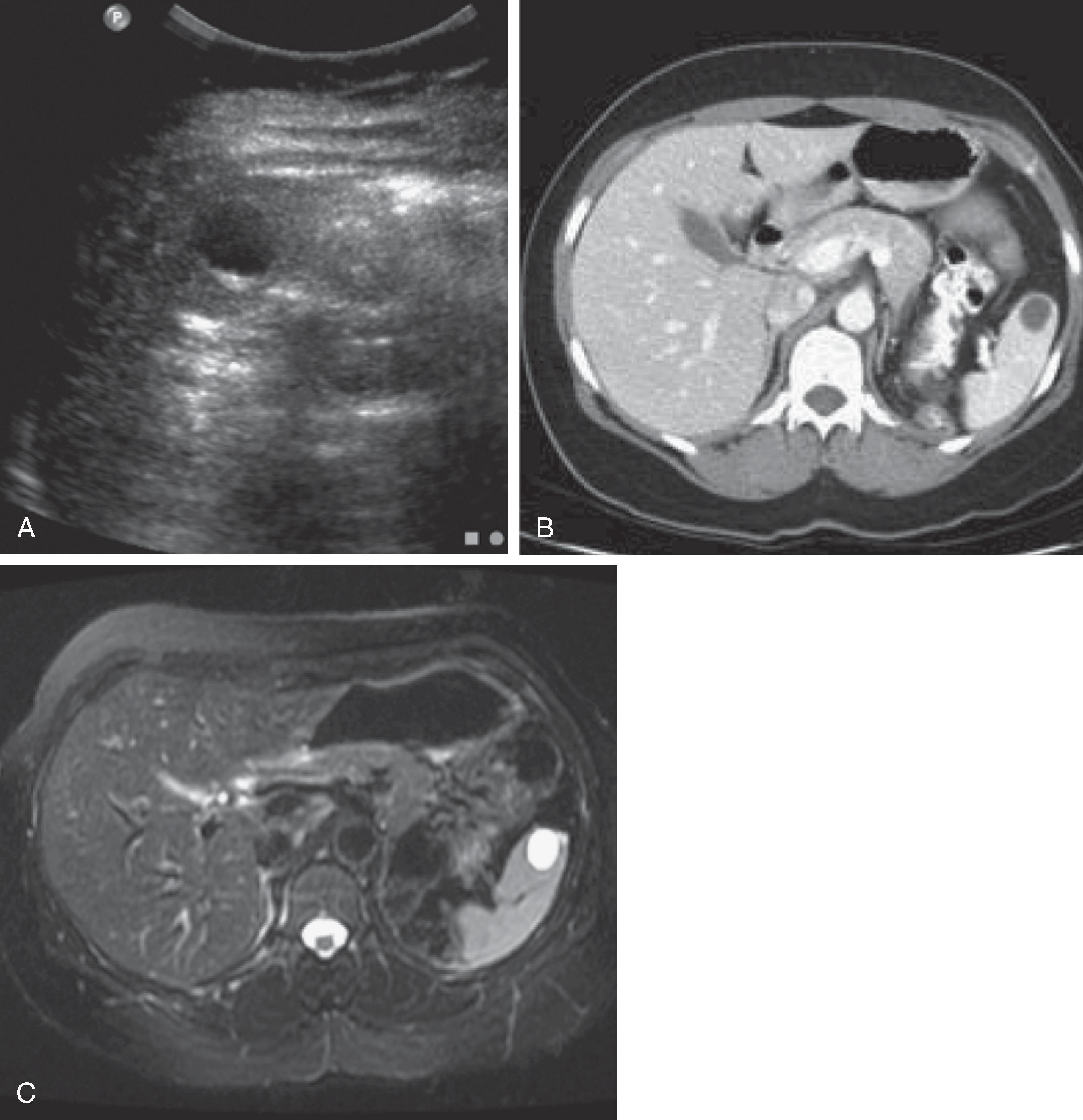
On CT, splenic cysts appear as homogeneous, well-defined, round or oval, low-enhancing or nonenhancing, hypodense lesions ( Fig. 62.3B ). The attenuation values typically range from 0 to 15 HU. Higher attenuation values are found in the presence of protein or blood degradation products. The cyst wall can be thick or partially calcified, and septations are sometimes observed. ,
On MRI, splenic cysts demonstrate low signal intensity on the T1-weighted images and high, uniform signal intensity on the T2-weighted images ( Fig. 62.3C ). Complicated cysts, because of the presence of proteinaceous fluid or hemorrhage, may demonstrate high signal intensity on the T1-weighted images and mixed signal intensity on the T2-weighted images. Cysts should not demonstrate any enhancement after the administration of gadolinium.
CT is the most useful imaging technique for detection and follow-up of pancreatitis with splenic complications. Imaging typically reveals pancreatitis and its sequelae. Subcapsular splenic fluid collections or hematomas appear as lentiform collections that flatten or indent the splenic contour ( Fig. 62.4 ). The appearance of the fluid collections depends on the amount of necrosis, infection, and hemorrhage. Evidence of fluid-fluid levels within a splenic pseudocyst favors the diagnosis of hemorrhage. Gas in a collection, although rare, confirms infection. Focal, wedge-shaped, or diffuse areas of decreased attenuation in the spleen are most likely to represent infarction. Portal vein thrombosis and pseudoaneurysms are typically detected with contrast-enhanced CT.
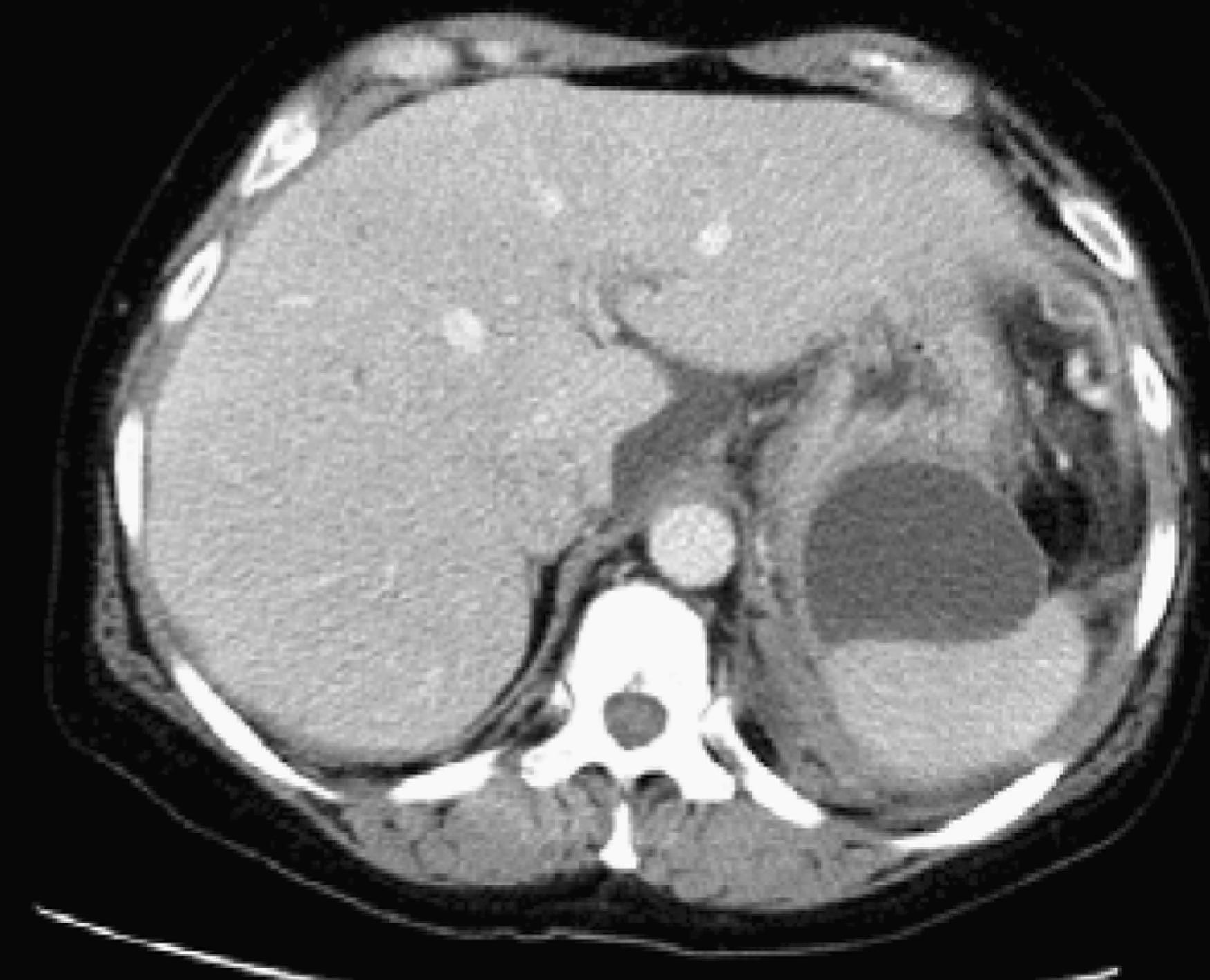
Percutaneous drainage of cysts within or around the spleen may be considered for definitive diagnosis (amylase level, gram stain and culture), prevention of splenic rupture, and to treat infection. However, percutaneous drainage of splenic pancreatic pseudocysts has been associated with significant complications.
Hemangioma is the most common benign neoplasm of the spleen, found in approximately 0.3% to 14% of autopsy specimens. Hemangiomas typically are asymptomatic and found incidentally. On occasion, they are multiple or diffuse, a condition called hemangiomatosis, or they are part of generalized angiomatosis, such as Klippel-Trénaunay-Weber syndrome. Rarely, these may be manifested with a palpable mass in the left upper quadrant, pain, or splenomegaly. Kasabach-Merritt syndrome, characterized by hemangiomatosis, thrombocytopenia, and intravascular coagulation, is a rare syndrome resulting from sequestration of red blood cells and platelets and consumption of clotting factors in the hemangiomas typically seen in early infancy. Spontaneous splenic rupture of splenic hemangiomas is extremely uncommon. Resection should be reserved for the rare situations, such as untreatable pain, diagnostic uncertainty, or compression of adjacent organs.
On gross examination, hemangiomas appear blue to red and spongy, and they are typically well circumscribed. Most splenic hemangiomas are cavernous and a few are capillary or may demonstrate both features. On histopathologic examination, they are nonencapsulated proliferations of vascular channels of various sizes lined by a single layer of plump endothelial cells with little intervening fibrous tissue filled with red blood cells. , Diffuse hemangiomatosis is a rare, benign neoplastic condition in which the entire spleen is replaced by neoplastic blood vessels interspersed with sparse connective tissue. ,
The imaging appearance of splenic hemangiomas is a spectrum from solid to mixed to purely cystic. On ultrasound, small splenic hemangiomas appear as discrete echogenic lesions similar to those in the liver ( Fig. 62.5 ). Large hemangiomas may appear as complex masses with both solid and cystic areas. Acoustic shadowing due to calcifications may be seen.
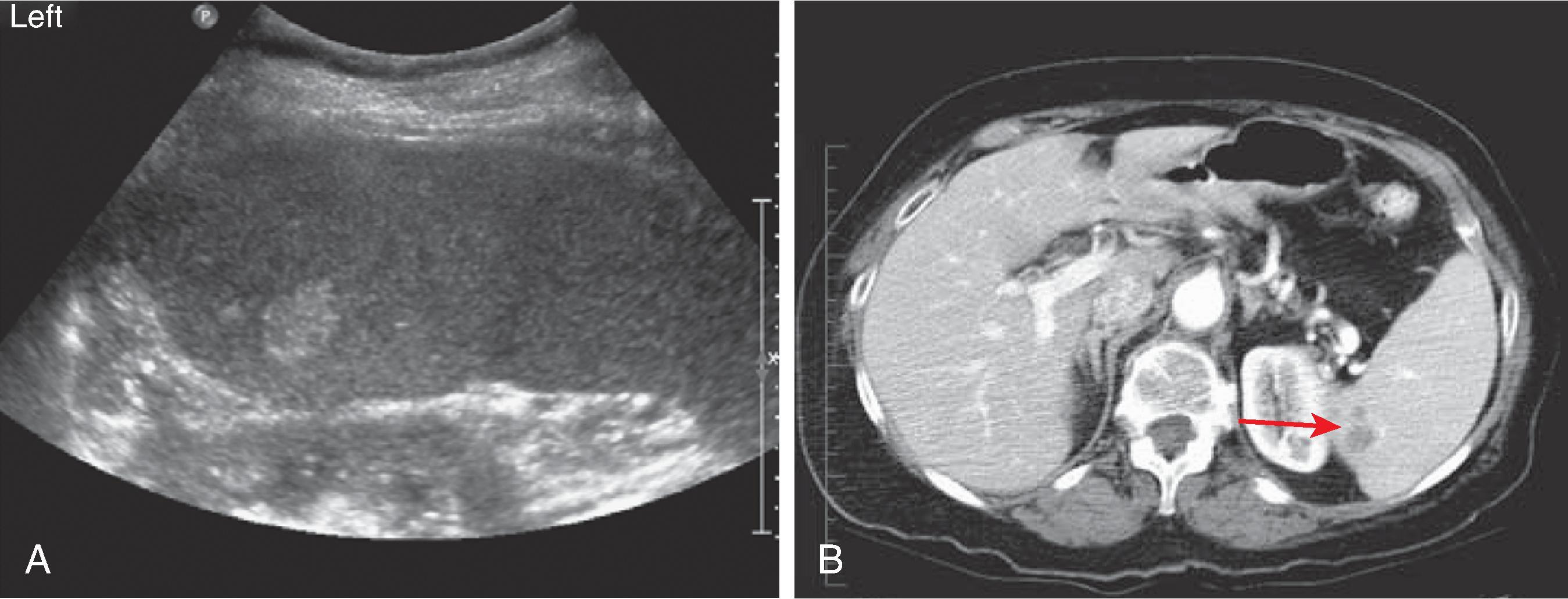
Hemangiomas often manifest as solid, homogeneous masses or complex cystic masses with slight hypodensity on nonenhanced CT scans. Punctate, peripheral, and curvilinear calcifications may be present. On contrast-enhanced CT, cavernous hemangiomas of the spleen may demonstrate a progressive centripetal enhancement pattern and become isodense on the delayed images, as can be seen in liver hemangiomas ( Fig. 62.6A and B ). However, this occurs less frequently in splenic hemangiomas than in hepatic hemangiomas probably reflecting the differences in vascular supply of the liver and spleen. , Often, enhancement may be mottled and in no particular geometric arrangement, with cystic components not demonstrating enhancement. Capillary hemangiomas are typically homogeneously hypervascular on postcontrast scanning.
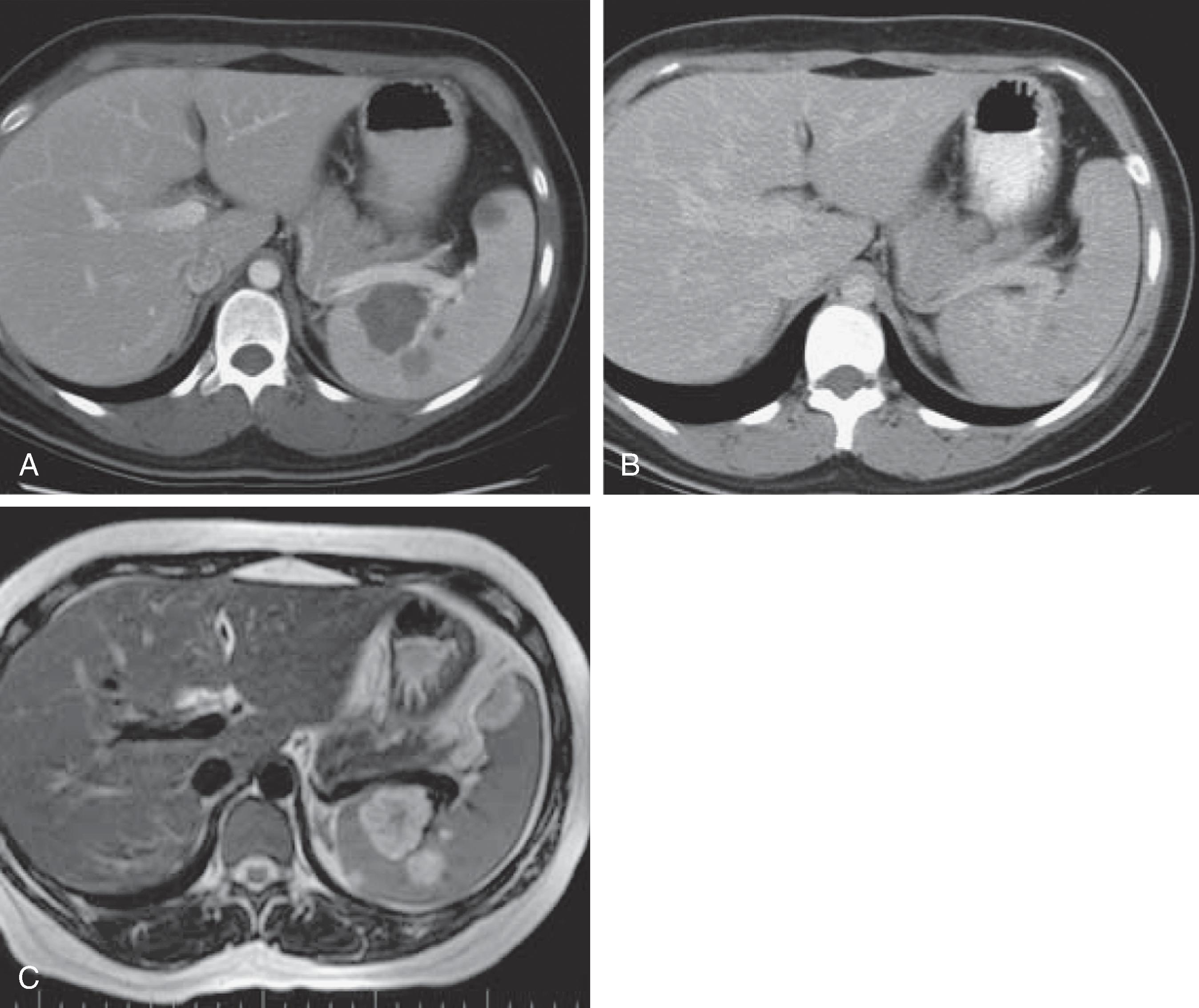
On MR studies, splenic hemangiomas are isointense to hypointense on the T1-weighted images and typically hyperintense on the T2-weighted images compared with the normal spleen ( Fig. 62.6C ) but can vary. Sometimes, a central fibrous scar may demonstrate persistent enhancement.
Splenic lymphangiomas are rare, benign, slow-growing, congenital lymphatic malformations. They are typically seen in childhood, with only a few reported cases in adults. Lesions can be isolated and solitary within the spleen, or the entire spleen may be replaced (i.e., splenic lymphangiomatosis). This may be part of a rare congenital malformation of the lymphatics called lymphangiomatosis. Lymphangiomatosis predominantly affects pediatric patients and typically involves multiple organs and locations, including the neck, mediastinum, and retroperitoneum. , Lymphangiomas of the spleen have also been associated with Klippel-Trénaunay-Weber syndrome.
In adults, splenic lymphangiomas are often asymptomatic. When symptoms are present, they are usually related to the increased size of the spleen and include left upper quadrant pain, nausea, and abdominal distention. , Associated coagulopathy, hypersplenism, and portal hypertension have been described.
Management varies from conservative treatment for small, asymptomatic lesions to partial or total splenectomy for large, symptomatic lesions. Subtotal splenic embolization is also described as an effective treatment option.
On gross examination, splenic lymphangiomas typically are subcapsular, multicystic lesions filled with watery pink proteinaceous fluid. On histologic evaluation, they are composed of multiple, thin-walled cysts of various sizes lined with a flat endothelium. Lymphangiomas often involve the capsule and trabeculae, where lymphatic structures are normally present. Lymphangiomas are traditionally classified as capillary, cavernous, or cystic, depending on the histologic findings.
Ultrasound typically shows multiple cysts that are a few millimeters to several centimeters in diameter and are divided by thin septations ( Fig. 62.7 ). , , Splenic lymphangiomas may have calcifications, and the finding of internal echoes depends on the presence of proteinaceous or hemorrhagic fluid. Vascularity within the walls and the septa can be demonstrated with color Doppler imaging.
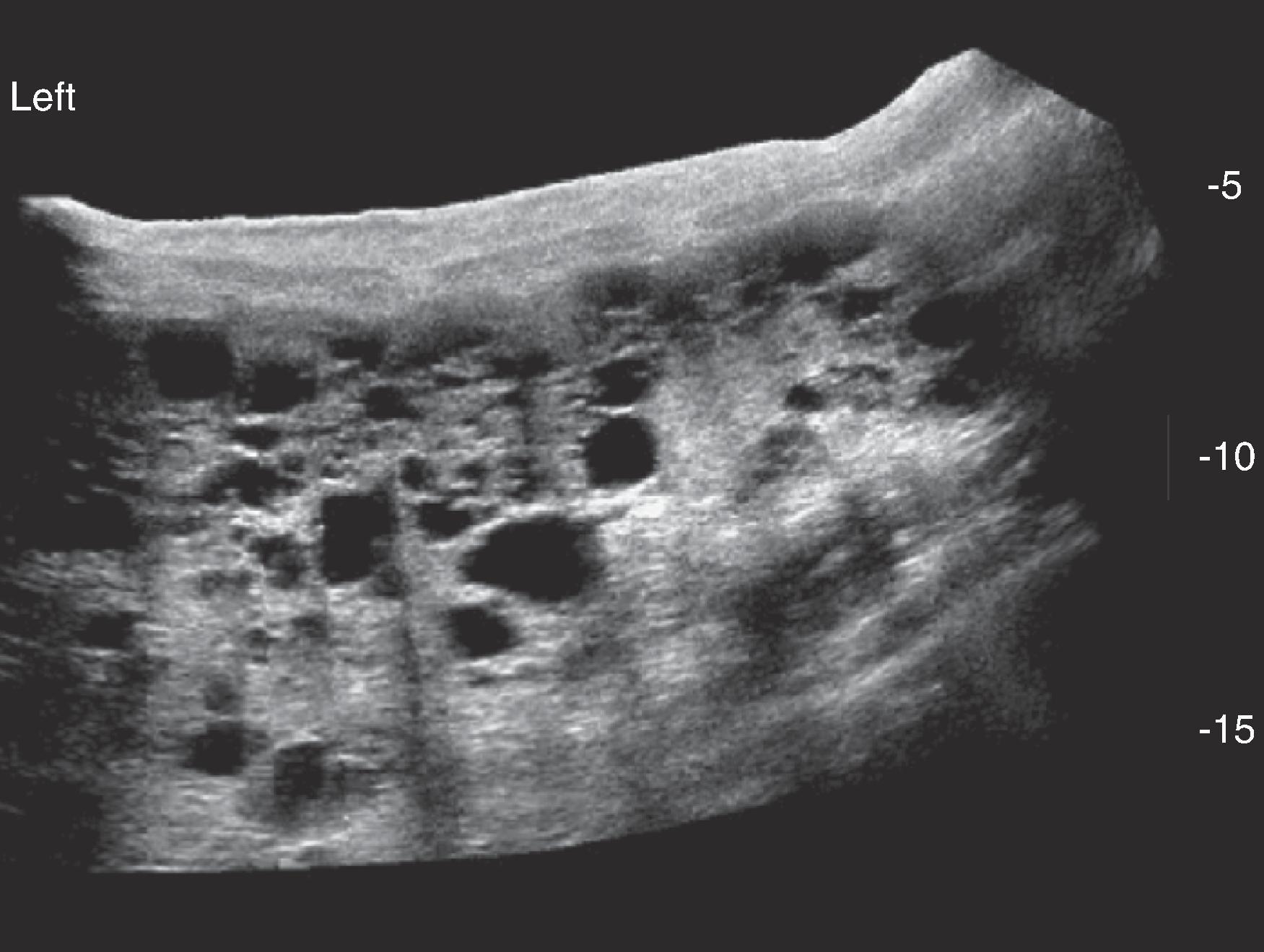
CT can reveal subcapsular, low-density, nonenhancing, sharply marginated, thin-walled cysts. Small, curvilinear or punctate calcifications may be observed. , After administration of an intravenous contrast agent, the septa may demonstrate enhancement. ,
MRI reveals multiple, well-defined cysts within the spleen. They appear hypointense on T1-weighted images and hyperintense on the T2-weighted sequences. , The cysts may demonstrate high signal intensity on the T1-weighted images if they contain proteinaceous or hemorrhagic fluid. The septa appear as hypointense structures on the T2-weighted sequences. These septa are usually better defined on contrast-enhanced CT and MR images.
When the lymphatic spaces are small, as in capillary lymphangiomas, the lesion may have a solid appearance on radiologic imaging, making a correct preoperative radiologic diagnosis difficult. Lymphangiomas do not demonstrate uptake of the radiopharmaceutical on 99m Tc-sulfur colloid scintigraphy.
Hamartoma of the spleen is a rare, benign tumor first described by Rokitansky in 1859 as a splenoma. Hamartomas are also known as a spleen within a spleen, post-traumatic scars, nodular hyperplasia, and hyperplastic nodules. They are usually discovered incidentally during diagnostic imaging, splenectomy, or autopsy. Most are described in case reports or small series and the reported incidence varies from 0.12% to 0.17%. The definitive diagnosis of a splenic hamartoma is rarely made on the basis of imaging. Hamartomas are often confirmed by pathologic evaluation after splenectomy. ,
No gender predilection has been demonstrated for hamartomas, and they can be found in any age group. Most hamartomas are solitary. Hamartomas of the spleen have been associated with hematologic disorders, tuberous sclerosis, malignant neoplasms, and Wiskott-Aldrich–like syndrome.
Hamartomas are usually discovered incidentally, and most patients are asymptomatic, but a large hamartoma may be manifested as a palpable mass or splenomegaly. Rupture of a splenic hamartoma is rare. Splenic hamartomas can be associated with hematologic disorders, including pancytopenia, anemia, and thrombocytopenia. This association probably results from sequestration of the hematopoietic cells in the abnormal vascular spaces. Resolution of these hematologic disorders after hamartoma resection has been reported. , A definitive diagnosis may be established with a percutaneous biopsy, although this often proves to be a challenge for the pathologist as it may be difficult to differentiate a hamartoma from a malignant neoplasm, and more often, splenectomy is needed for a definitive diagnosis. ,
On gross examination, hamartomas are well-circumscribed, solid lesions that compress the surrounding parenchyma. They vary in size from less than 1 cm to more than 20 cm in diameter. On histologic examination, splenic hamartomas are composed of disorganized red pulp elements with reticuloendothelial cell proliferation. Normal white pulp is usually absent. , They contain a mixture of unorganized sinus-like structures lined by endothelial cells surrounded by fibrotic cords of predominant splenic red pulp without a true capsule. , Special immunohistochemical techniques can be used to differentiate hamartomas from hemangiomas. The etiology of splenic hamartomas is controversial; some authors consider splenic hamartomas to be congenital in origin, whereas others consider hamartomas to be true neoplasms or to be an acquired proliferative process. ,
On sonography, hamartomas are typically well-defined, homogeneous masses ( Fig. 62.8A ). The reported appearance varies from isoechoic to mildly hyperechoic or hypoechoic. The mass may contain cystic areas or coarse calcifications. , On color Doppler images, the mass often demonstrates increased blood flow. Some investigators report that sonography is more sensitive than CT in depicting hamartomas of the spleen.
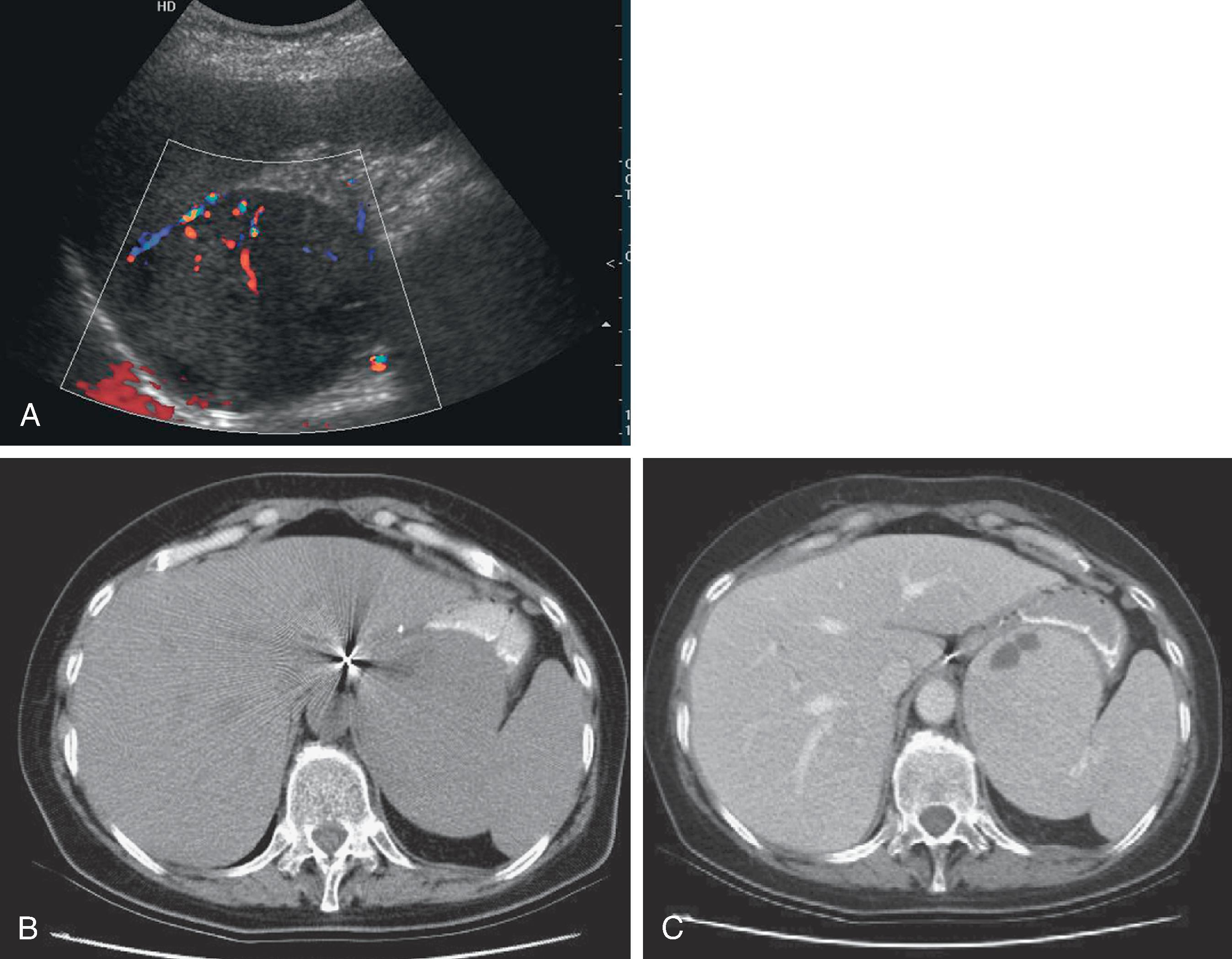
A contour abnormality is often the only visible finding on CT ( Fig. 62.8B ). A typical hamartoma is isodense or mildly hypodense on nonenhanced and on enhanced CT scans ( Fig. 62.8C ). Heterogeneous enhancement can be observed in larger lesions; uniform and prolonged contrast enhancement is often shown on the delayed images.
On MRI, hamartomas are well-defined, isointense masses on the T1-weighted images. In a series of five patients, four were imaged with T2 sequences. In three of these, the lesions were heterogeneously hyperintense, and in one, the mass was hypointense relative to the normal spleen. In the same series, all hamartomas demonstrated diffuse, heterogeneous enhancement in the early phases and became more uniformly enhanced on delayed images on dynamic contrast-enhanced sequences.
Angiography, sometimes performed for preoperative embolization, may demonstrate a hypervascular mass with peripheral tumor vessels and tumor stains. ,
Splenic inflammatory pseudotumor is a rare, benign lymphoid lesion. Although the cause and pathogenesis are unknown, it is thought that inflammatory pseudotumors result from an unusual, nonspecific, inflammatory reparative response to injury such as infection. ,
Like most other benign splenic tumors, inflammatory pseudotumors are usually asymptomatic. In the typical scenario, this lesion is discovered incidentally, sometimes presumed to represent lymphoma.
On gross examination, the lesions are often well circumscribed and white. On histopathologic examination, the lesions are composed of spindle cells and various proportions of mixed inflammatory cells, including small lymphocytes, plasma cells, and histiocytes. A zonal distribution is characteristic, with central foci of necrosis and hemorrhage, foamy histiocytes, granulomas, and giant cells. Calcifications can be present.
Unfortunately, radiologic imaging techniques do not permit preoperative diagnosis of these lesions. Splenic inflammatory pseudotumors are typically misdiagnosed as other masses, such as lymphoma or metastatic disease. ,
Ultrasound usually demonstrates a well-defined hypoechoic mass and acoustic shadowing when calcifications are present.
Unenhanced CT scans reveal a rounded mass with low attenuation with or without calcifications. Enhancement can be homogeneous or heterogeneous, and delayed enhancement patterns are often described. Central, stellate, low-density areas may persist within the mass, probably corresponding to focal areas of fibrosis.
On MRI, these lesions appear isointense to the splenic parenchyma on T1-weighted images. Both heterogeneously hypointense and hyperintense lesions compared with normal spleen tissue have been described on T2-weighted images. , As with CT, most investigators describe a peripheral enhancement pattern with gradual, delayed central enhancement from the periphery to the center on the dynamic sequences. ,
Sclerosing nodular angiomatoid transformation (SANT), also known as multinodular or sclerosing hemangioma, is a rare benign vascular lesion consisting of multiple angiomatoid nodules surrounded by dense fibrous stroma coalescing centrally to form a scar. It is similar to a hamartoma in composition, but consists of three types of blood vessels (capillaries, small veins and sinusoids), whereas hamartoma consists of only sinusoid-type vessels.
On imaging, lesions are generally solitary (95%) and round with a lobulated margin. They are heterogeneously hypoenhancing on arterial and portal venous phase on both CT and MRI. Characteristically, SANT demonstrates delayed progressive enhancement, peripheral enhancing radiating lines and decreased signal on in-phase imaging compared with out-of-phase imaging consistent with hemosiderin deposition ( Fig. 62.9 ).
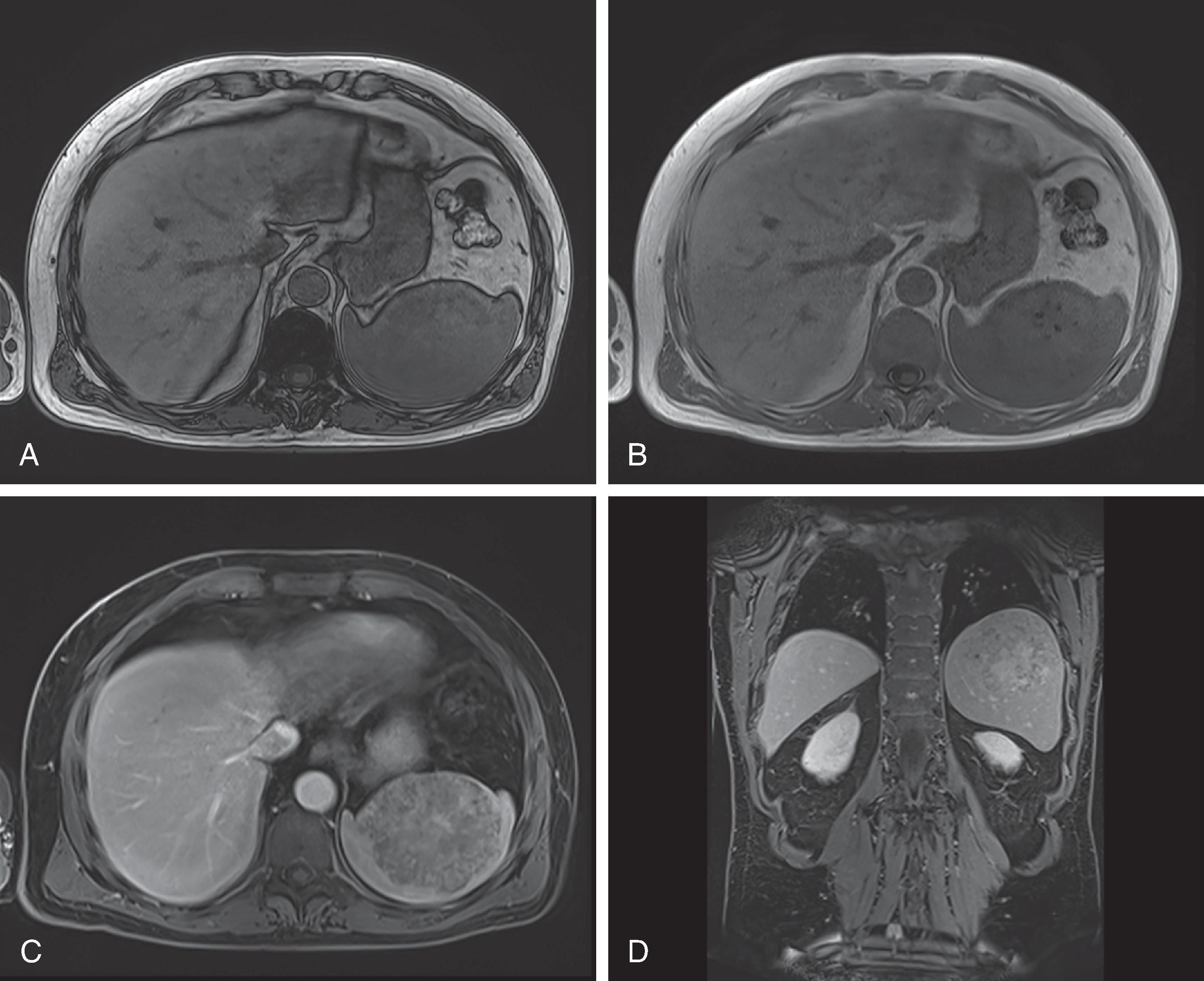
Inflammation and infection of the spleen are manifested in three distinct patterns: generalized splenomegaly without discerning focal lesions; solitary lesions; and a diffuse, miliary or macronodular pattern with or without splenomegaly. Generalized splenomegaly is a nonspecific finding and can be found in various diseases, including infections and inflammatory diseases (see Box 62.1) . Multiple splenic nodular lesions, usually smaller than 2 cm in diameter, are commonly associated with nonbacterial infections, such as fungal and granulomatous infections. An abscess may be manifested as a solitary lesion. The presence of gas in a lesion, although rare, is pathognomonic of a pyogenic infection.
Portal hypertension
Splenic vein thrombosis
Congestive heart failure
Acute infections (e.g., infectious mononucleosis)
Chronic infections (e.g., miliary tuberculosis, malaria)
Sarcoidosis
Systemic lupus erythematosus
Hemolytic anemias (e.g., malaria, polycythemia vera)
Lymphomas, leukemias
Metastases
Extramedullary hematopoiesis
Storage diseases (e.g., Gaucher’s disease, amyloidosis)
Lymphangiomatosis
Hemangiomatosis
Peliosis
Become a Clinical Tree membership for Full access and enjoy Unlimited articles
If you are a member. Log in here